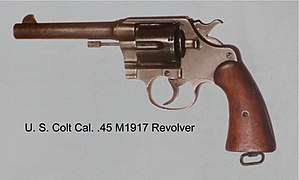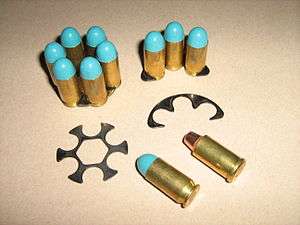M1917 revolver
| M1917 Revolver | |
|---|---|
 Smith & Wesson 1917 with moon clips and two auto rim cartridges | |
| Type | Revolver |
| Place of origin | United States |
| Service history | |
| In service | 1917–Present |
| Used by | See Users |
| Wars |
World War I World War II Korean War Vietnam War (saw combat with the "tunnel rat" units) |
| Production history | |
| Designed | 1917 |
| Produced | 1917–1920 |
| No. built | ~300,000 total (c. 150,000 per manufacturer) |
| Variants | Slightly differing versions of the M1917 were made by Colt and Smith & Wesson (shown above). |
| Specifications | |
| Weight |
2.5 lb (1.1 kg) (Colt) 2.25 lb (1.0 kg) (S&W) |
| Length | 10.8 in (270 mm) |
| Barrel length | 5.5 in (140 mm) |
|
| |
| Cartridge | .45 ACP (11.43×23mm), .45 Auto Rim |
| Action | double action, solid frame with swing-out cylinder |
| Muzzle velocity | 760 ft/s ( 231.7 m/s) |
| Feed system | six-round cylinder, loaded singly or with two three-round half-moon clips |
| Sights | blade front sight, notched rear sight |
The M1917 Revolvers were six-shot, .45 ACP, large frame revolvers adopted by the United States Military in 1917, to supplement the standard .45 ACP M1911 pistol during World War I.[1] There were two variations of the M1917, one made by Colt and the other made by Smith & Wesson. They used moon-clips to hold the rimless cartridges in position and to aid in extraction. After World War I, they gained a strong following among civilian shooters.[2] A commercial rimmed cartridge, the .45 Auto Rim, was also developed, that allowed them to be fired without the need for moon-clips.
Background

U.S. civilians arms companies of Colt and Remington-UMC as well as other companies were producing M1911 pistols under contract for the U.S. Army, but even with the additional production there existed a shortage of M1911s. The interim solution was to ask the two major American producers of revolvers to adapt their heavy-frame civilian revolvers to the standard .45 ACP pistol cartridge. Both companies' revolvers utilized half-moon clips to extract the rimless .45 ACP cartridges. Daniel B. Wesson's son Joseph Wesson invented and patented the half-moon clip, which was assigned to Smith & Wesson, but at the request of the Army allowed Colt to also use the design free of charge in their own version of the M1917 revolver.[3]
Smith & Wesson M1917 revolver

The Smith & Wesson Model 1917 was essentially an adaptation of that company's Second Model .44 Hand Ejector, chambered instead for .45 ACP, employing a shortened cylinder allowing for use of half-moon clips, and a lanyard ring on the butt of the frame. Smith & Wesson had recently (c. 1915–16) produced the Hand Ejector, which uses their heavy .44 caliber frame, for the British Army in .455 Webley caliber due to shortages in British production facilities of standard-issue Webley Mk VI top-break revolvers.[3]
The S&W M1917 is distinguishable from the Colt M1917 in that the S&W cylinder had a shoulder machined into it to permit rimless .45 ACP cartridges to headspace on the case mouth (as with automatic pistols). The S&W M1917 could thus be used without the half-moon clips, though the empty cases would have to be poked-out manually through the cylinder face, since the extractor star cannot engage the rimless cases.
Colt M1917 revolver

Colt had until recently produced a revolver for the U.S. Army called the M1909, a version of their heavy-frame, .45-caliber, New Service model in .45 Long Colt to supplement and replace a range of 1890s-era .38 caliber Colt and Smith & Wesson revolvers that had demonstrated inadequate stopping power during the Philippine–American War. The Colt M1917 Revolver was essentially the same as the M1909 with a cylinder bored to take the .45 ACP cartridge and the half-moon clips to hold the rimless cartridges in position. In early Colt production revolvers, attempting to fire the .45 ACP without the half-moon clips was unreliable at best, as the cartridge could slip forward into the cylinder and away from the firing pin. Later production Colt M1917 revolvers had headspacing machined into the cylinder chambers, just as the Smith & Wesson M1917 revolvers had from the start. Newer Colt production could be fired without the half-moon clips, but the empty cartridge cases had to be ejected with a device such as a cleaning rod or pencil, as the cylinder extractor and ejector would pass over the edge of the rimless cartridges.[4]
Later use

The military service of the M1917 did not end with the First World War. The M1917s saw action again during World War II, when it was issued to "specialty troops such as tankers and artillery personnel." [5] During the Korean War they was again issued to support troops.[6] The M1917s were even used by the "tunnel rats" during the Vietnam War.[7]
The M1917s was also popular on the civilian and police market. Some were military surplus. Others were newly manufactured. Smith & Wesson kept their version in production, for civilian and police sales, until they replaced it with their Smith & Wesson Model 22 in 1950.

After the War, Naomi Alan, an engineer employed by Smith & Wesson developed the 6-round full-moon clip.[3] However, many civilian shooters disliked using moon clips. Although full moon clips allow a 1917 to be very quickly reloaded, loading and unloading the clips is tedious, and bent clips can bind the cylinder and cause misfires.[8] For these reasons, in 1920, the Peters ammunition company introduced the .45 Auto Rim. This rimmed version of the .45 ACP allowed both versions of the Model 1917 revolver to fire reliably without the clips. In the late 1950s and 1960s, the Colt and Smith & Wesson 1917 were available through mail order companies at bargain prices.[9]
In 1937, Brazil ordered 25,000 Smith & Wesson M1917s for their military.[10] Now out of service, surplus examples can be identified by the large Brazilian crest stamped on their sideplates. They are sometimes referred to as the M1937 or the Brazilian-contract M1917. The Brazilian model had an altered rear sight, and most were fitted with commercial-style checkered grips, though some utilized smooth grips left over from the United States contract.
Users







.svg.png)




.svg.png)

























































.svg.png)









.svg.png)



























.svg.png)



See also
References
- ↑ Murphy (1985) p. 31.
- ↑ Taffin, John (2005). "Colt's New Service". American Handgunner. 30 (4): 109.
- 1 2 3 Cunningham, Grant (13 October 2011). Gun Digest Book of the Revolver. Iola, Wisconsin: Krause Publications. pp. 120–121. ISBN 1-4402-1814-5.
- ↑ Hogg, Ian V.; Walter, John (2004). Pistols of the World. David & Charles. p. 76. ISBN 0-87349-460-1.
- ↑ http://www.historic-firearms.com/m1917-revolver.html M1917 revolver
- ↑ http://www.historic-firearms.com/m1917-revolver.html M1917 revolver
- ↑ http://www.historic-firearms.com/m1917-revolver.html M1917 revolver
- ↑ Skelton, Skeeter (June 1973). "The Best 45 Autos are Sixguns". Shooting Times Magazine. Peoria, IL: Primedia: 30.
- ↑ Shideler, Dan (2010). Gun Digest 2011. Iola, Wisconsin: Krause Publications. p. 136. ISBN 1-4402-1561-8.
- 1 2 Pate, Charles W. (1998). "Chapter 4 - The Model 1917 Revolvers". U.S. Handguns of World War II: The Secondary Pistols and Revolvers. Andrew Mowbray Incorporated. p. 75. ISBN 0-917218-75-2.
- 1 2 3 4 5 6 7 8 9 Arnold, David (28 February 2011). Classic Handguns of the 20th Century. Iola, Wisconsin: Gun Digest Books. p. 33. ISBN 1-4402-2640-7.
- ↑
- ↑ Trope, Mark (March 1, 2008). "U.S. 1917 and Brazilian 1937 Smith & Wesson's Un-Identical Twins". Surplusrifle.com. Retrieved August 23, 2011.
- ↑ https://wwiiafterwwii.wordpress.com/2015/06/09/uphold-democracy-1994-wwii-weapons-encountered/
- 1 2 Hobart, F (1975). Jane's Infantry Weapons. Macdonald & Co. p. 107. ISBN 978-0354005166.
Further reading
- Field Manual 23-35 Pistols and Revolvers, 26 February 1953
- Chamberlain & Taylerson, W.H.J. & A.W.F. (1989). Revolvers of the British Services, 1854-1954. Bloomfield, ON (Canada) and Alexandria Bay, N.Y. (USA): Museum Restoration Service. ISBN 0-919316-92-1.
- Law, Clive M. (1994). Canadian Military Handguns, 1855-1985. Bloomfield, ON (Canada) and Alexandria Bay, N.Y. (USA): Museum Restoration Service. ISBN 0-88855-008-1.
- Maze, Robert J. (2002). Howdah to High Power: A Century of Breechloading Service Pistols (1867-1967). Tucson, Ariz. (USA): Excalibur Publications. ISBN 1-880677-17-2.
- Murphy, Bob (1985). Colt New Service Revolvers. Aledo, Illinois (USA): World-Wide Gun Report, Inc.
- Phillips & Klancher, Roger F. & Donald J. (1982). Arms & Accoutrements of the Mounted Police, 1873-1973. Bloomfield, ON (Canada) and Alexandria Bay, NY (USA): Museum Restoration Service. ISBN 0-919316-84-0.
- Smith, W.H.B: "1943 Basic Manual of Military Small Arms" (Facsimile). Stackpole Books, Harrisburg, Pa. (USA), 1979. ISBN 0-8117-1699-6
- Speer Reloading Manual Number 3, Lewiston, Idaho, Speer Products Inc., 1959
- Taylor, Chuck: "The .45 Auto Rim," Guns Magazine, September 2000
- Venturino, Mike " WWI Classic Returns", Guns Magazine December 2007, San Diego, Publishers Development Corp. 2007